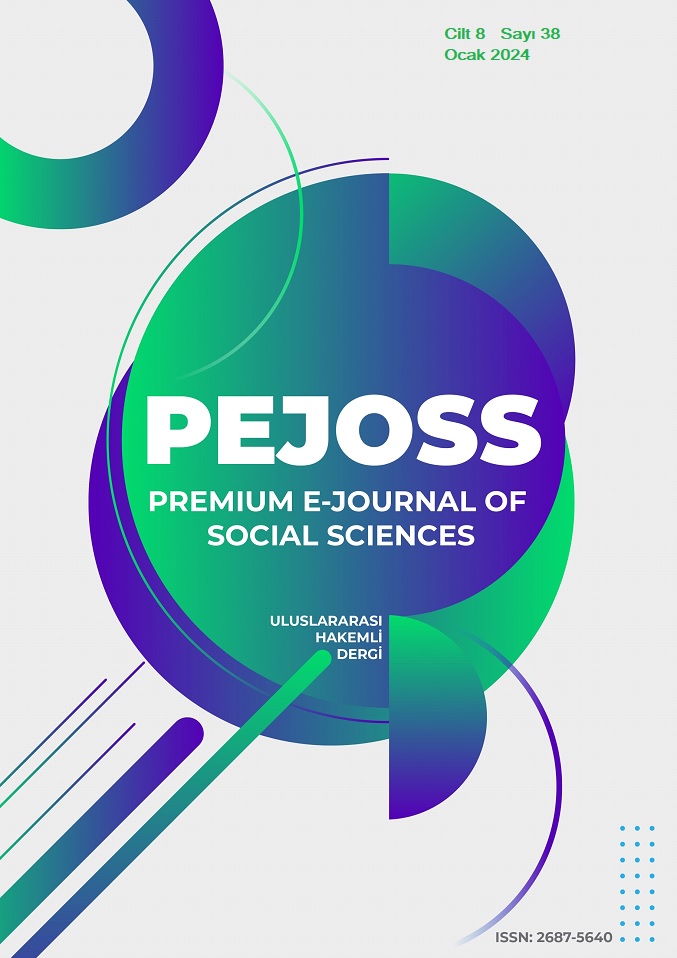Education and Sociological Status of Disadvantaged Women: The Case of Gaziemir Public Education Center
DOI:
https://doi.org/10.5281/zenodo.10642726Keywords:
Disadvantaged Women, Women, Education, Gaziemir Public Education CenterAbstract
Being disadvantaged directly affects social life. Women, the elderly, minorities, the disabled, immigrants, ex-convicts and children are called disadvantaged groups. The opinions of 12 disadvantaged female trainees who received education in Gaziemir Public Education Center were sought in order to evaluate the sociological status and perspectives of lifelong learning, especially among women who could not complete their education due to the exclusion and discrimination they were exposed to. Demographic information and semi-structured interview techniques were used for the research data. This research was conducted using qualitative research methods. The reason for using this method is that it allows the systematic examination of the narratives of the participant’s experiences and the determination of perceptions. Opinions and evaluations will be made by giving a code so that the identity information of the trainees is not visible. Disadvantaged people lack the skills to meet their own needs, sustain their lives, or encounter obstacles in using these skills. It is seen that there are economic and cultural factors among these obstacles. In the sociological literature, women, the elderly, minorities, the disabled, immigrants, ex-convicts and children are seen as disadvantaged groups. In this study, the education of women from disadvantaged groups and their perspectives on lifelong learning were examined. Despite the fact that the education level is high in rural areas where the opportunities for girls are less than boys, starting from the birth of discrimination against women, it is seen that most of the girls do not go to school, especially after eight years of compulsory education. It is seen that women who cannot benefit from formal education sufficiently try to improve themselves by participating in vocational training and personal development programs in Public Education Centers. It is seen that the gender phenomenon is at the forefront of the career choices of women who benefit from formal education. It is seen that women who cannot benefit from adequate educational opportunities remain silent more when they are subjected to physical and psychological violence or sexual abuse, but they know better how to protect their personal rights as their education level rises. The role of men in society is determined as working outside the home and being responsible for taking care of the home, while the role of women is determined as housework and child care. These roles defined by the genders have prevented the education of women. The knowledge, skills and advantages to be gained from learning opportunities in applications are important in terms of raising awareness in the information society we live in. In addition to personal development in education and training, it provides human resources and women's employment that will support economic development by applying it in vocational training.
Downloads
References
Bayır, Ö. G. (2019). Dezavantajlı Gruptaki Çocuklarla Eğitim Süreci: Sınıf Öğretmeni Adaylarının Görüşleri. Eskişehir Osmangazi Üniversitesi Sosyal Bilimler Dergisi, 20 (Özel sayı), 1-14. https://doi.org/10.17494/ogusbd.548528
Bilir, N. (2020). Yaşlılık Tanımı, Yaşlılık Kavramı, Epidemiyolojik Özellikler. Arzu Ertürk, Ayşe Bahadır, Filiz Koşar , Yaşlılık ve Solunum Hastalıkları içinde (13-33). TÜSAD.
Çeviker, A., Mumcu, H., Şekeroğlu, M., & Bayrak, M. (2018). Unicef'e göre Türkiye'de dezavantajlı kabul edilen grupların sportif etkinliklerle sosyal uyumun sağlanması. Siirt Üniversitesi Sosyal Bilimler Enstitüsü Dergisi, 221-238.
Erkek, S. & Karagöz, H. (2009). Kadının İş Hayatındaki yeri ve karşılaştığı sorunlar. Konya Ticaret Odası.
Gençtürk, Z., & Korkmaz, A. (2019). Eski hükümlü bireylerin işgücü piyasasına ilişkin görüşleri üzerine bir araştırma. Süleyman Demirel Üniversitesi İktisadi ve İdari Bilimler Fakültesi Dergisi, 24(2), 369-384.
Göregenli, M. (2012). Temel Kavramlar: Önyargı, Kalıpyargı ve Ayrımcılık. Çayır, K., & Ceyhan, M. A. (Ed.), Ayrımcılık: çok boyutlu yaklaşımlar içinde (ss. 17-28). İstanbul Bilgi Üniversitesi Yayınları.
Karabıyık, İ. (2012). Türkiye'de çalışma hayatında kadın istihdamı. Marmara Üniversitesi İ.İ.B.F. Dergisi, 32(1), 231-260.
Karasar, N. (2016). Bilimsel Araştırma Yöntemleri: Kavramlar, İlkeler, Teknik. Nobel Akademik Yayıncılık.
Karataş, Z. (2017). Sosyal bilim araştırmalarında paradigma değişimi: Nitel yaklaşımın yükselişi. Türkiye Sosyal Hizmet Araştırmaları Dergisi, 1(1), 68-86.
Namal, M., Berke, M., & Çetinay, H. (2021). Eski Hükümlü İstihdamında Karşılaşılan Sorunlar ve Çözüm Önerileri. Journal of Yasar University, 16(63), 1338-1354. https://doi.org/10.19168/jyasar.916740
Özaydınlık, K. (2014). Toplumsal Cinsiyet Temelinde Türkiye'de Kadın ve Eğitim. Sosyal Politika Çalışmaları Dergisi, (33), 93-112. https://doi.org/10.21560/spcd.03093
Şahin, T. (2009). Sosyal Dışlanma ve Yoksulluk İlişkisi. (1. baskı). T.C. Başbakanlık Sosyal yardımlaşma ve Dayanışma Müdürlüğü.
Tuskan, A. A. (2012). Toplumsal cinsiyet toplumda kadına biçilen roller ve çözümleri. Türkiye Barolar Birliği Dergisi, 445-449.
Türkiye İstatistik Kurumu (TÜİK) (2016,2021). Adrese Dayalı Nüfus Kayıt Sistemi. https://data.tuik.gov.tr/ Bulten/Index?p=Adrese-Dayali-Nufus-Kayit-Sistemi-Sonuclari-2021-45500
Türkiye İstatistik Kurumu (TÜİK) (2020a). Hanehalkı İşgücü Araştırması. https://data.tuik.gov.tr/ Bulten/Index?p=Labour-Force-Statistics-2020-37484
Türkiye İstatistik Kurumu (TÜİK) (2020b). Ulusal Eğitim İstatistikleri Veri Tabanı. https://data.tuik.gov.tr/ Bulten/Index?p=National-Education-Statistics-2022-49756
Türkiye İstatistik Kurumu (TÜİK) (2022). İşgücü İstatistikleri, https://data.tuik.gov.tr/Bulten/Index?p= Isgucu-Istatistikleri-Ocak-2022-45644
Uluslararası Af Örgütü (UAÖ). (2021). Ayrımcılık. https://www.amnesty.org.tr/icerik/ayrimcilik.
Unicef. (2016). Dünya Çocuklarının Durumu raporu. Unicef Türkiye Milli Komitesi: https://www.unicefturk.org/yazi/unicef-dunyanin-en-dezavantajli-cocuklarini-yoksulluk-egitimsizlik-ve-erken-olumler-bekliyor
Vikipedi (2005). Cinsiyet Ayrımcılığı. https:// https://tr.wikipedia.org/wiki/Cinsiyet_eşitsizliği
Vikipedi (2016). Sosyal Dışlanma. https://tr.wikipedia.org/wiki/Sosyal_dışlanma
Vikipedi (2018). Azınlıklar. https://tr.wikipedia.org/wiki/Azınlık
Vikipedi (2020). Pozitif Ayrımcılık. https://tr.wikipedia.org/wiki/Pozitif_ayrımcılık
Downloads
Published
How to Cite
Issue
Section
License
Copyright (c) 2024 Premium e-Journal of Social Science (PEJOSS)

This work is licensed under a Creative Commons Attribution 4.0 International License.


